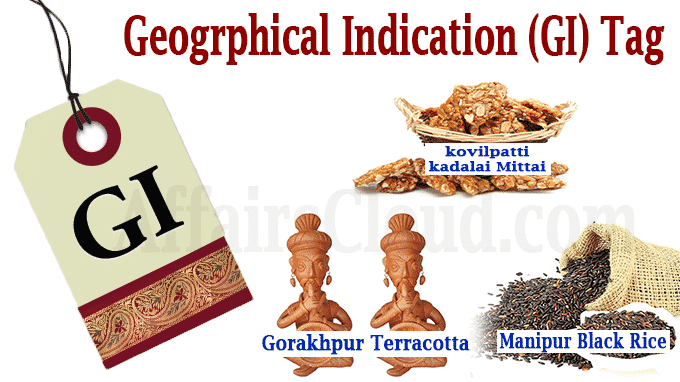On April 30, 2020 Chak-Hao, the black rice of Manipur, the terracotta work of Gorakhpur & Kovilpatti kadalai-mittai has been granted with the Geographical Indication(GI) tag. Application filing
Application filing
- Chak-Hao- the Consortium of Producers of Chak-Hao (Black Rice), Manipur and was facilitated by the Department of Agriculture, Government of Manipur and the North Eastern Regional Agricultural Marketing Corporation Limited (NERAMAC).
- Gorakhpur terracotta- Laxmi Terracotta Murtikala Kendra in Uttar Pradesh.
- Kovilpatti kadalai mittai- the Kovilpatti Regional Kadalaimittai Manufacturers filed on July 3, 2014, the same was published in GI journal on November 29, 2019 inviting for objections if any.
Chak-Hao
i.The black rice is glutinous rice cultivated in Manipur over centuries, is characterised by its special aroma& is consumed mainly after being cooked like rice or kheer.
ii.It has a deep black colour and when cooked, it usually turns purple. It’s dark purple colour is primarily a product of its anthocyanin content which is considered as boosting up the antioxidants level, apart from this it also has vitamins, minerals, fibre, proteins, among others.
iii.It is a bit heavier as compared to other varieties of rice but its natural flavour is rich and sweet & is used as traditional medicine & takes the longest cooking time of 40-45 minutes due to the presence of a fibrous bran layer and higher crude fibre content.
iv.Health Benefits- prevents and manages ailments such as atherosclerosis, diabetes, Alzheimer’s disease, hypertension, high cholesterol levels, arthritis, allergies, ageing signs and even cancer.
Gorakhpur terracotta
i.It is a centuries-old traditional art form, the work is done with bare hands including the ornamentation & natural color which stays fast for a long time. There are more than 1,000 varieties of terracotta work designed by the local craftsmen
ii.Some of the major products of craftsmanship include the Hauda elephants, Mahawatdar horse among others.
Kovilpatti kadalai mittai
i.It is a peanut candy manufactured in Kovilpatti and adjacent towns and villages in Thoothukudi district, the southern part of Tamil Nadu.
ii.It is produced by using groundnuts and vellam (jaggery) and water from the river Thamirabarani which enhances the taste naturally. It is sold as single rectangular chunks, or rather cuboids, sealed in packets.
iii.For decades it was traditionally prepared during village festivals using palm jaggery and groundnuts from nearby districts. The switch to sugarcane jaggery happened in the pre-independence era, around the 1940s
About GI Tag:
- It is a sign used on products that have a specific geographical origin and possess qualities or a reputation that are due to that origin. It provides similar rights and protection to holders like intellectual properties rights like Copyright, Patent, Trademark etc.
- It ensures that none other than those registered as authorised users (or at least those residing inside the geographic territory) are allowed to use the popular product name.
- In India, GI registration is administered by the Geographical Indications of Goods (Registration and Protection) Act, 1999 which came into force with effect from September 2003. The 1st Indian product to get a GI tag is Darjeeling Tea in 2004.
- It is covered as a component of intellectual property rights (IPRs) under the Paris Convention for the Protection of Industrial Property.
- At the International level, GI is governed by the World Trade Organisation’s (WTO’s) Agreement on Trade-Related Aspects of Intellectual Property Rights (TRIPS).




